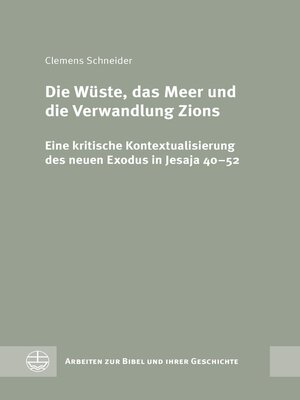Die Wüste, das Meer und die Verwandlung Zions
ebook ∣ Eine kritische Kontextualisierung des neuen Exodus in Jesaja 40–52 · Arbeiten zur Bibel und ihrer Geschichte (ABG)
By Clemens Schneider

Sign up to save your library
With an OverDrive account, you can save your favorite libraries for at-a-glance information about availability. Find out more about OverDrive accounts.
Find this title in Libby, the library reading app by OverDrive.



Search for a digital library with this title
Title found at these libraries:
| Library Name | Distance |
|---|---|
| Loading... |
Die Untersuchung setzt sich kritisch mit der klassischen These eines neuen Exodus in der ältesten deuterojesajanischen Schriftprophetie (Jesaja 40–52) auseinander. Deuterojesaja war nicht als theologische Werbeschrift zum Auszug aus Babylon, sondern von vornherein als heilsprophetische Variation einer konventionellen altorientalischen Städtetheologie konzipiert. Die Erschaffung des Weges für Jakob-Israel und die Verwandlung der Wüste und des Meeres stehen im Zusammenhang der reaktivierten Königsherrschaft JHWHs auf dem Zion. Ein neuer Exodus wird lediglich in den redaktionellen Versen Jes 51,10b–11; 52,11f. nachgewiesen. Diese stellen schon einen Bezug zu protojesajanischen Texten sowie Jesaja 60–62 her. Erst in diesem Stadium sind markante Bezüge zu einer bereits nachpriesterschriftlichen Exodus-Landnahmeerzählung im Hexateuch nachweisbar. [The Desert, the Sea and the Transformation of Zion. A Critical Contextualization of the New Exodus in Isaiah 40–52]
The study critically examines the classic thesis of a new exodus in the oldest Deutero-Isaiah scriptural prophecy (Isaiah 40-52). Deutero-Isaiah was not conceived as a theological advertising pamphlet about the exodus from Babylon, but from the outset as a salvation-prophetic variation of a common ancient oriental urban theology. The creation of the way for Jacob-Israel and the transformation of the desert and the sea are in the context of YHWH's reactivated kingship on Zion. A new exodus is only mentioned in the editorial verses Isaiah 51:10b–11; 52.11f. proven. These already establish a connection to proto-Isaiah texts in addition to Isaiah 60–62. Only at this stage can striking references to a post-priestly written exodus narrative in the Hexateuch be detected.







